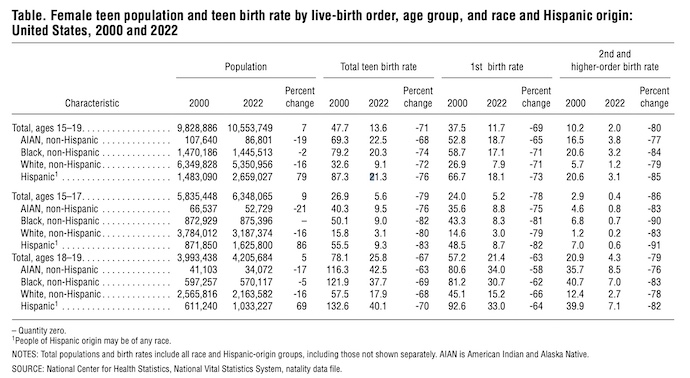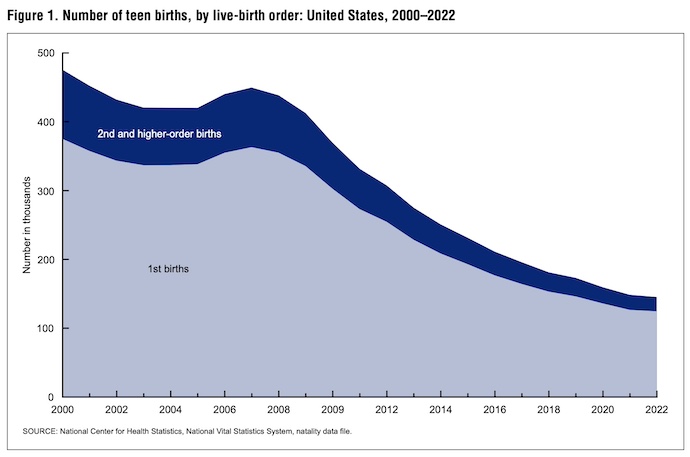
Rifqyhsn Design/istock via Getty
Report reveals a 69% decline in teen birth rates from 2000 to 2022
The National Vital Statistics Reports reveal a 69% drop in teen births from 2000 to 2022, highlighting changes across different racial and ethnic groups.
A comprehensive study published in the National Vital Statistics Reports highlights a significant 69% drop in births to teens under 20, from 475,104 in 2000 to 145,313 in 2022, even as the number of female teenagers grew by 7%. Authored by Anne K. Driscoll, PhD, Danielle M. Ely, PhD, and Brady E. Hamilton, PhD, the report thoroughly analyzes first and second birth rates among teenagers, emphasizing significant declines and demographic variations from 2000 to 2022.
According to the report, the teen birth rate plummeted from 47.7 to 13.6 births per 1,000 teenagers, marking a 71% reduction. The study distinguishes between first births and second or higher-order births. First births saw a 67% decrease, from 374,925 in 2000 to 124,586 in 2022. More notably, second and higher-order births dropped by 79%, from 100,179 to 20,727. This greater decline in subsequent births signifies a substantial reduction in repeated teen pregnancies.

The report provides an in-depth look at the trends across different racial and ethnic groups. Notably, the decline in birth rates was consistent across all groups of teenagers, but the levels of decline varied.
- Non-Hispanic White: The birth rate fell by 72%, from 32.6 to 9.1 births per 1,000 teenagers.
- Non-Hispanic Black: Experienced a 74% decline, with rates dropping from 79.2 to 20.3.
- Hispanic: Saw a 76% reduction, with birth rates decreasing from 87.3 to 21.3.
- Non-Hispanic American Indian/Alaska Native: The birth rate declined by 68%, from 69.3 to 22.5.

The report further broke down the data by specific age groups, revealing that younger teenagers (ages 15–17) experienced more significant declines than older teenagers (ages 18–19).
- Ages 15–17: The birth rate dropped by 79%, from 26.9 to 5.6 births per 1,000 teenagers.
- Ages 18–19: The birth rate fell by 67%, from 78.1 to 25.8 births per 1,000 teenagers.
The authors attribute these remarkable declines to several factors, including older age at first sexual activity, decreased sexual activity among sexually experienced teens, and increased use of effective contraception. These behavioral changes have contributed significantly to the reductions in first and second births among teenagers.
For healthcare providers, these findings have significant implications. The reduction in teen pregnancies, especially second and higher-order births, suggests successful interventions in sexual education and contraceptive access. However, the persistence of racial and ethnic disparities indicates the need for tailored strategies to address the unique challenges faced by different communities.
The report calls for continued efforts to sustain and further these declines. This includes enhancing access to reproductive health services, promoting comprehensive sex education, and addressing socioeconomic factors that contribute to higher teen birth rates in certain populations. Additionally, further research is needed to explore the long-term impacts of these trends on both mothers and children.
The National Vital Statistics Reports provide a clear and detailed picture of the changing landscape of teen births in the United States. The significant declines in first and second births among teenagers, alongside the noted demographic variations, underscore the effectiveness of public health interventions over the past two decades. Healthcare providers, policymakers, and community leaders are encouraged to build on this progress, ensuring that all teenagers have the resources and support they need to make informed decisions about their reproductive health.




